Risk and Return Analysis for Cochlear Ltd
VerifiedAdded on 2023/01/19
|8
|1596
|52
AI Summary
This article provides a risk and return analysis for Cochlear Ltd, including the use of the Capital Asset Pricing Model and portfolio construction. It also compares the stock's return to the market index and discusses the benefits of diversification.
Contribute Materials
Your contribution can guide someone’s learning journey. Share your
documents today.
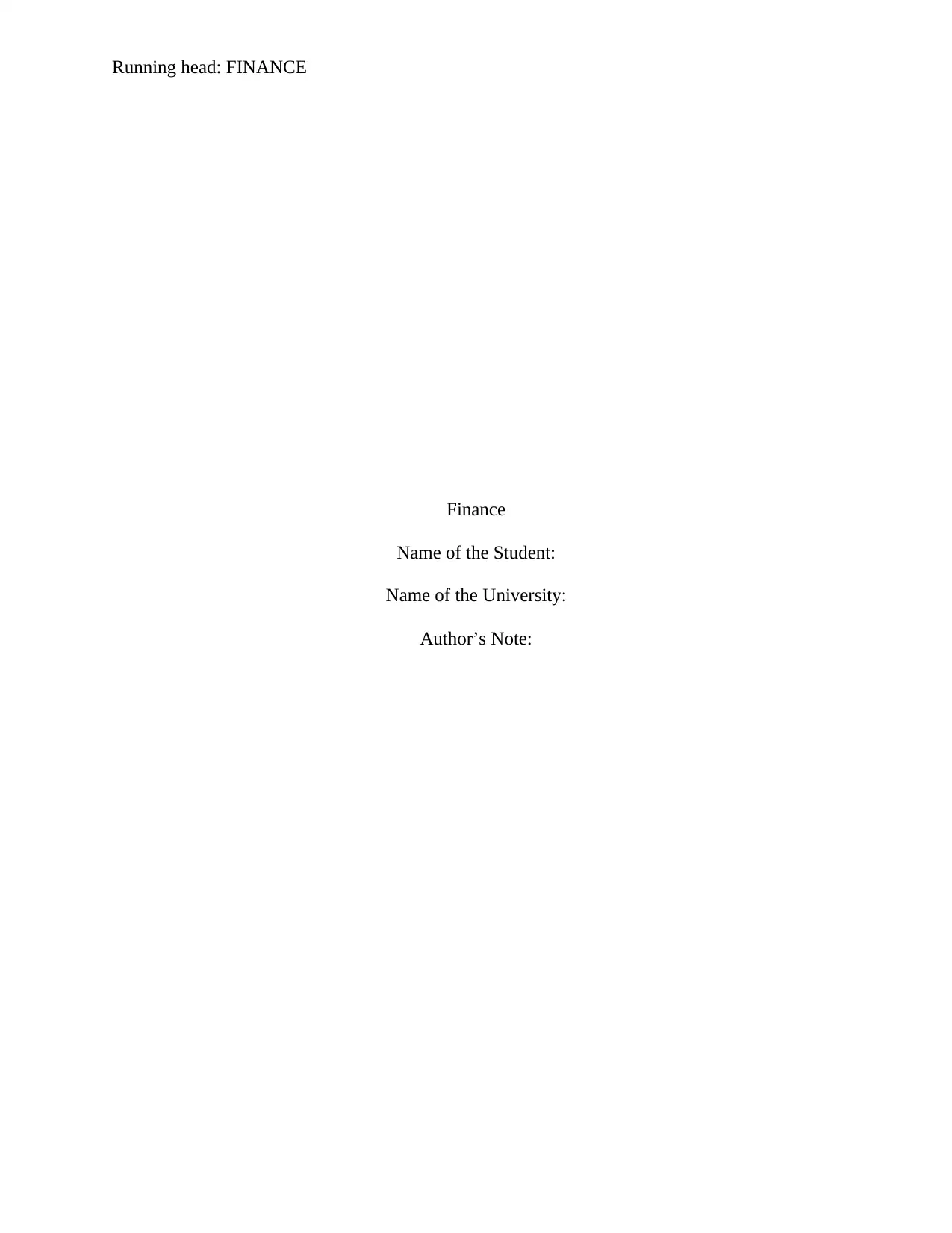
Running head: FINANCE
Finance
Name of the Student:
Name of the University:
Author’s Note:
Finance
Name of the Student:
Name of the University:
Author’s Note:
Secure Best Marks with AI Grader
Need help grading? Try our AI Grader for instant feedback on your assignments.
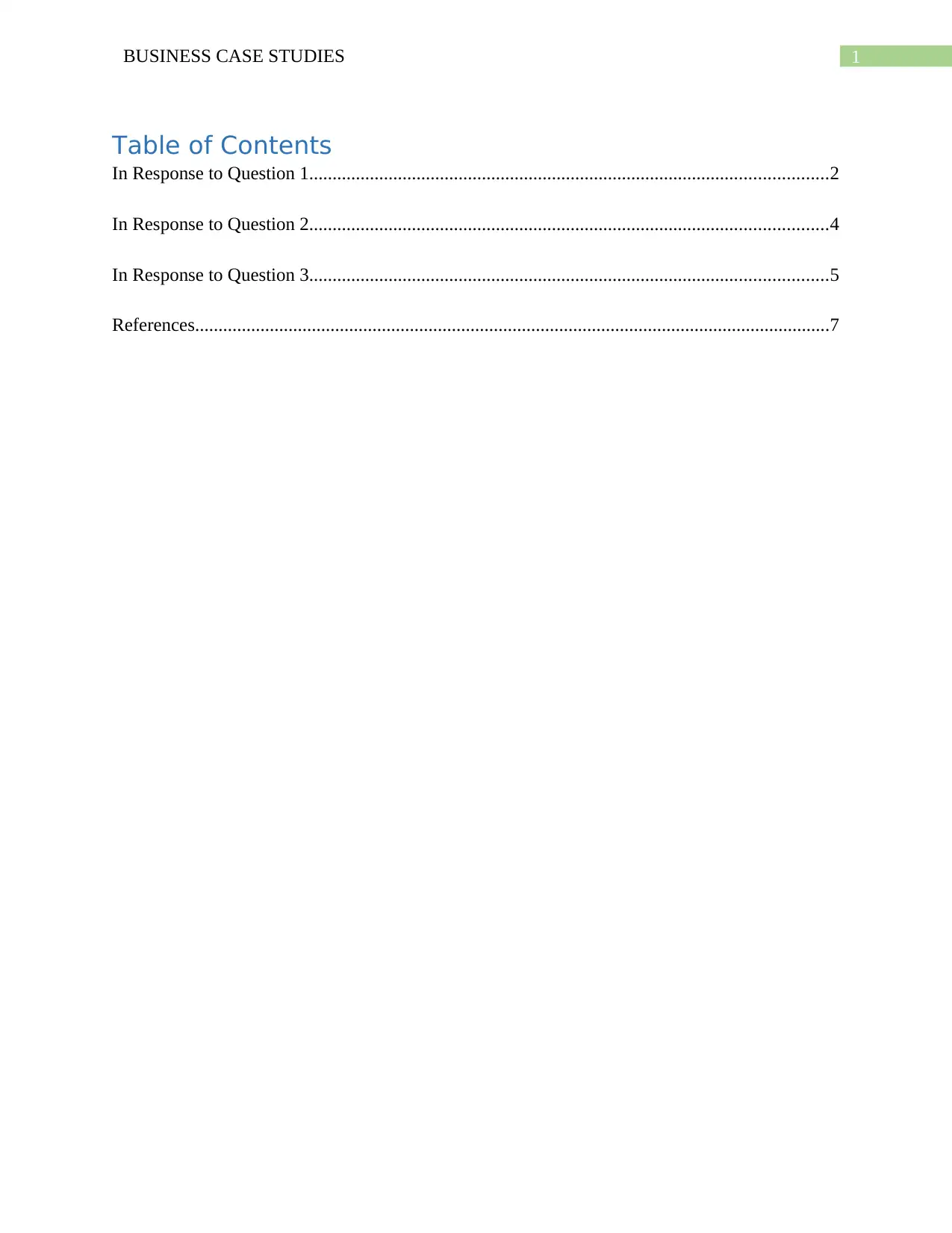
1BUSINESS CASE STUDIES
Table of Contents
In Response to Question 1...............................................................................................................2
In Response to Question 2...............................................................................................................4
In Response to Question 3...............................................................................................................5
References........................................................................................................................................7
Table of Contents
In Response to Question 1...............................................................................................................2
In Response to Question 2...............................................................................................................4
In Response to Question 3...............................................................................................................5
References........................................................................................................................................7
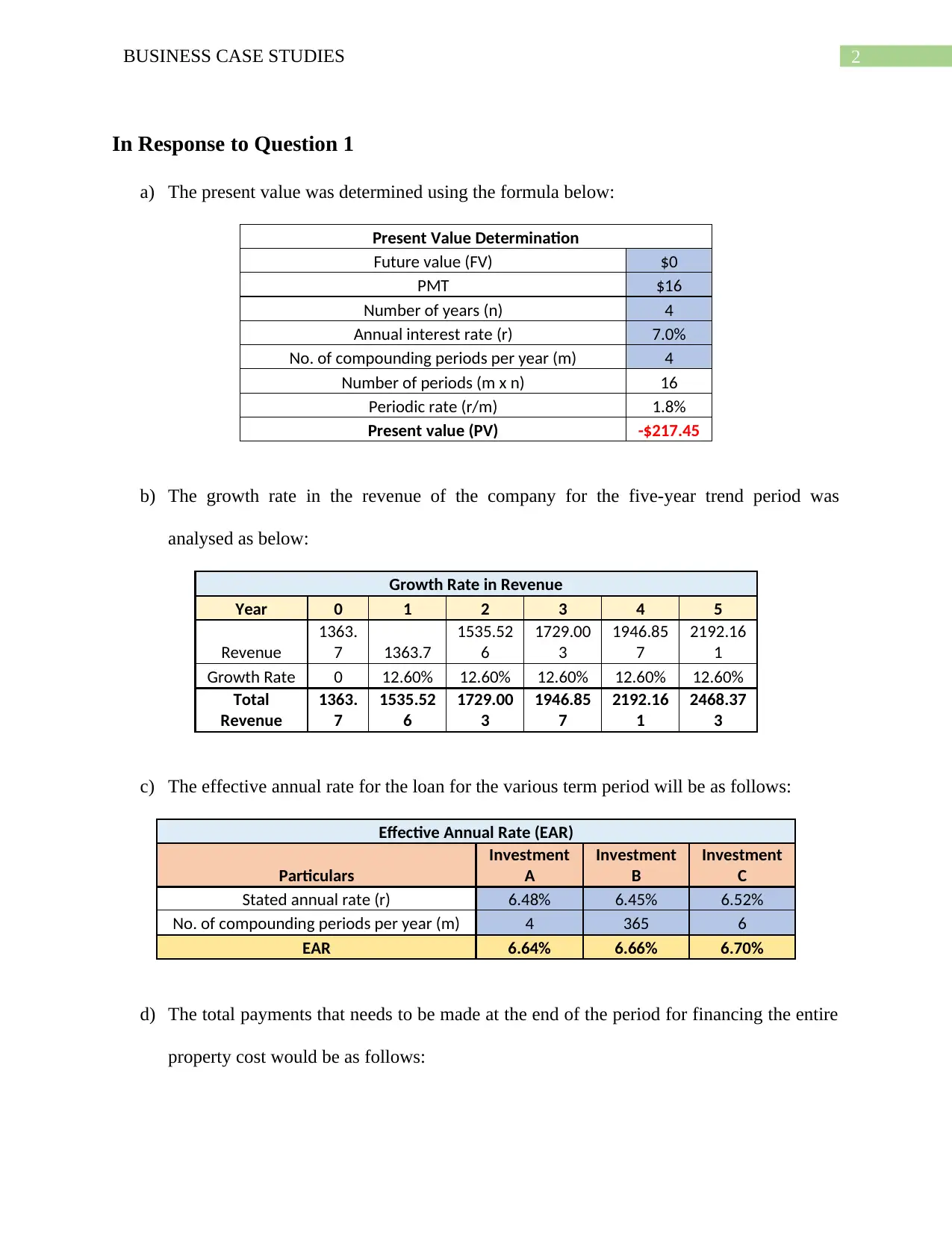
2BUSINESS CASE STUDIES
In Response to Question 1
a) The present value was determined using the formula below:
Present Value Determination
Future value (FV) $0
PMT $16
Number of years (n) 4
Annual interest rate (r) 7.0%
No. of compounding periods per year (m) 4
Number of periods (m x n) 16
Periodic rate (r/m) 1.8%
Present value (PV) -$217.45
b) The growth rate in the revenue of the company for the five-year trend period was
analysed as below:
Growth Rate in Revenue
Year 0 1 2 3 4 5
Revenue
1363.
7 1363.7
1535.52
6
1729.00
3
1946.85
7
2192.16
1
Growth Rate 0 12.60% 12.60% 12.60% 12.60% 12.60%
Total
Revenue
1363.
7
1535.52
6
1729.00
3
1946.85
7
2192.16
1
2468.37
3
c) The effective annual rate for the loan for the various term period will be as follows:
Effective Annual Rate (EAR)
Particulars
Investment
A
Investment
B
Investment
C
Stated annual rate (r) 6.48% 6.45% 6.52%
No. of compounding periods per year (m) 4 365 6
EAR 6.64% 6.66% 6.70%
d) The total payments that needs to be made at the end of the period for financing the entire
property cost would be as follows:
In Response to Question 1
a) The present value was determined using the formula below:
Present Value Determination
Future value (FV) $0
PMT $16
Number of years (n) 4
Annual interest rate (r) 7.0%
No. of compounding periods per year (m) 4
Number of periods (m x n) 16
Periodic rate (r/m) 1.8%
Present value (PV) -$217.45
b) The growth rate in the revenue of the company for the five-year trend period was
analysed as below:
Growth Rate in Revenue
Year 0 1 2 3 4 5
Revenue
1363.
7 1363.7
1535.52
6
1729.00
3
1946.85
7
2192.16
1
Growth Rate 0 12.60% 12.60% 12.60% 12.60% 12.60%
Total
Revenue
1363.
7
1535.52
6
1729.00
3
1946.85
7
2192.16
1
2468.37
3
c) The effective annual rate for the loan for the various term period will be as follows:
Effective Annual Rate (EAR)
Particulars
Investment
A
Investment
B
Investment
C
Stated annual rate (r) 6.48% 6.45% 6.52%
No. of compounding periods per year (m) 4 365 6
EAR 6.64% 6.66% 6.70%
d) The total payments that needs to be made at the end of the period for financing the entire
property cost would be as follows:
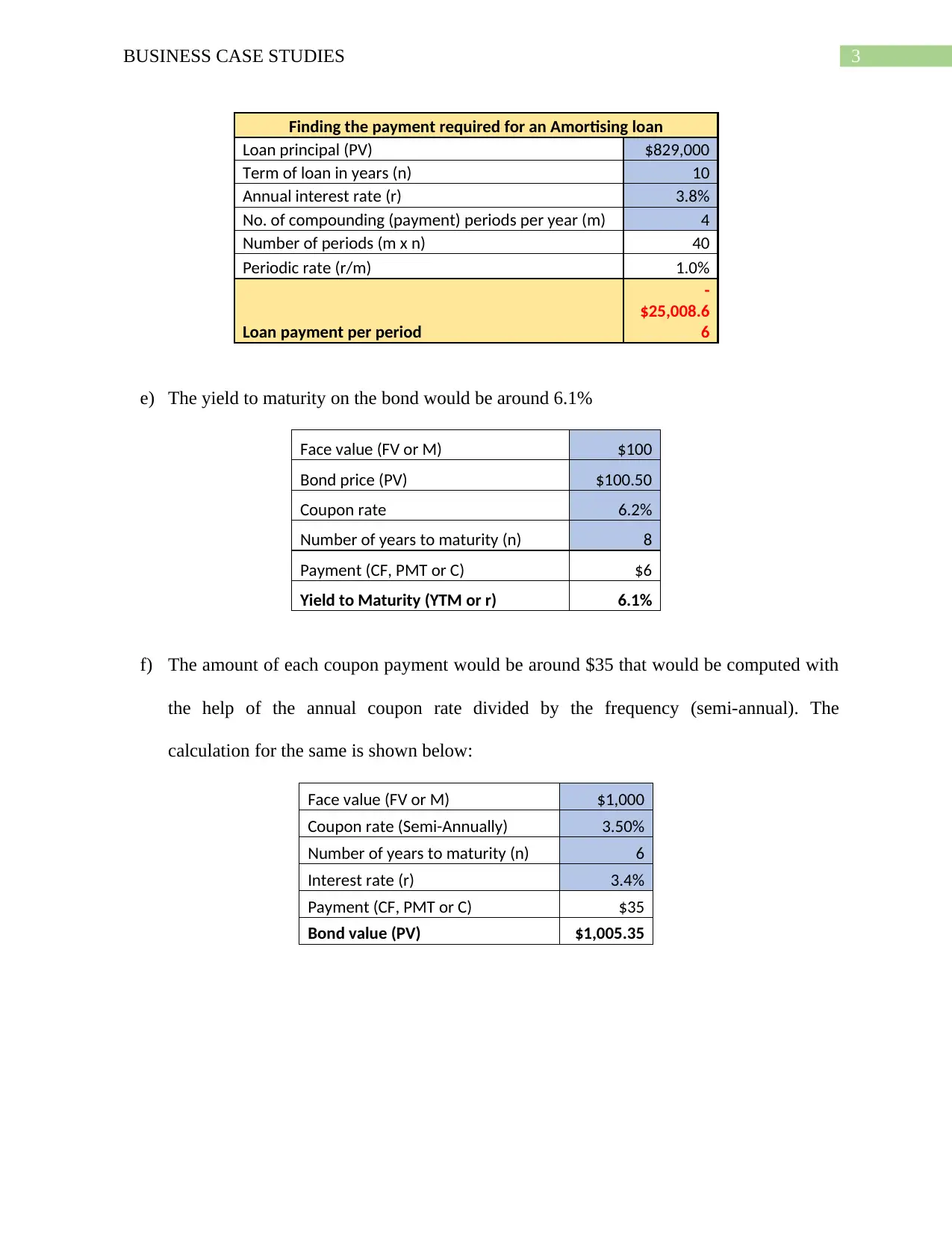
3BUSINESS CASE STUDIES
Finding the payment required for an Amortising loan
Loan principal (PV) $829,000
Term of loan in years (n) 10
Annual interest rate (r) 3.8%
No. of compounding (payment) periods per year (m) 4
Number of periods (m x n) 40
Periodic rate (r/m) 1.0%
Loan payment per period
-
$25,008.6
6
e) The yield to maturity on the bond would be around 6.1%
Face value (FV or M) $100
Bond price (PV) $100.50
Coupon rate 6.2%
Number of years to maturity (n) 8
Payment (CF, PMT or C) $6
Yield to Maturity (YTM or r) 6.1%
f) The amount of each coupon payment would be around $35 that would be computed with
the help of the annual coupon rate divided by the frequency (semi-annual). The
calculation for the same is shown below:
Face value (FV or M) $1,000
Coupon rate (Semi-Annually) 3.50%
Number of years to maturity (n) 6
Interest rate (r) 3.4%
Payment (CF, PMT or C) $35
Bond value (PV) $1,005.35
Finding the payment required for an Amortising loan
Loan principal (PV) $829,000
Term of loan in years (n) 10
Annual interest rate (r) 3.8%
No. of compounding (payment) periods per year (m) 4
Number of periods (m x n) 40
Periodic rate (r/m) 1.0%
Loan payment per period
-
$25,008.6
6
e) The yield to maturity on the bond would be around 6.1%
Face value (FV or M) $100
Bond price (PV) $100.50
Coupon rate 6.2%
Number of years to maturity (n) 8
Payment (CF, PMT or C) $6
Yield to Maturity (YTM or r) 6.1%
f) The amount of each coupon payment would be around $35 that would be computed with
the help of the annual coupon rate divided by the frequency (semi-annual). The
calculation for the same is shown below:
Face value (FV or M) $1,000
Coupon rate (Semi-Annually) 3.50%
Number of years to maturity (n) 6
Interest rate (r) 3.4%
Payment (CF, PMT or C) $35
Bond value (PV) $1,005.35
Secure Best Marks with AI Grader
Need help grading? Try our AI Grader for instant feedback on your assignments.

4BUSINESS CASE STUDIES
In Response to Question 2
a) The Capital Asset Pricing Model was applied for determining the required rate of return
of the Cochlear Company. The required rate of return for both the stocks were generated
by the following formula:
Capital Asset Pricing Model (Re) = Risk Free Rate of Return + (Beta*(Return on
Market-Risk Free Rate of Return)).
The Risk free rate of return taken for the analysis of the stock was around 1.95% and the
beta of the stock was determined by regressing the returns generated from the COH Stock
over the ASX 200 Index. The beta for the stock was determined to be around 0.98 times
and the same was determined to be somewhat positively contributed with the stock
(Bhattacharyya 2016). The required rate of return for the stock was determined to be
around 3.27% and the required return for the hypothetical company was determined to be
around 1.68% (Aliu, Pavelkova and Dehning 2017).
Cochlear Ltd ASX 200 Index
Capital Asset Pricing Model Capital Asset Pricing Model
Beta
0.986157
6 Beta -0.2
Risk Free Rate 1.95% Risk Free Rate 1.95%
Return on Market 3.29% Return on Market 3.29%
Required Rate of Return 3.27% Required Rate of Return
1.68
%
b) The portfolio was constructed by including both stocks in the form of Cochlear Ltd and
Hypothetical Company. The weights given to each of the stock was around 50% for each
of the stocks. The required rate of return generated by each of the stocks were taken into
consideration while determining the required return of the stocks. The required rate of
return of the portfolio is around 2.47% and the beta of the stock is around 0.39 times. On
In Response to Question 2
a) The Capital Asset Pricing Model was applied for determining the required rate of return
of the Cochlear Company. The required rate of return for both the stocks were generated
by the following formula:
Capital Asset Pricing Model (Re) = Risk Free Rate of Return + (Beta*(Return on
Market-Risk Free Rate of Return)).
The Risk free rate of return taken for the analysis of the stock was around 1.95% and the
beta of the stock was determined by regressing the returns generated from the COH Stock
over the ASX 200 Index. The beta for the stock was determined to be around 0.98 times
and the same was determined to be somewhat positively contributed with the stock
(Bhattacharyya 2016). The required rate of return for the stock was determined to be
around 3.27% and the required return for the hypothetical company was determined to be
around 1.68% (Aliu, Pavelkova and Dehning 2017).
Cochlear Ltd ASX 200 Index
Capital Asset Pricing Model Capital Asset Pricing Model
Beta
0.986157
6 Beta -0.2
Risk Free Rate 1.95% Risk Free Rate 1.95%
Return on Market 3.29% Return on Market 3.29%
Required Rate of Return 3.27% Required Rate of Return
1.68
%
b) The portfolio was constructed by including both stocks in the form of Cochlear Ltd and
Hypothetical Company. The weights given to each of the stock was around 50% for each
of the stocks. The required rate of return generated by each of the stocks were taken into
consideration while determining the required return of the stocks. The required rate of
return of the portfolio is around 2.47% and the beta of the stock is around 0.39 times. On
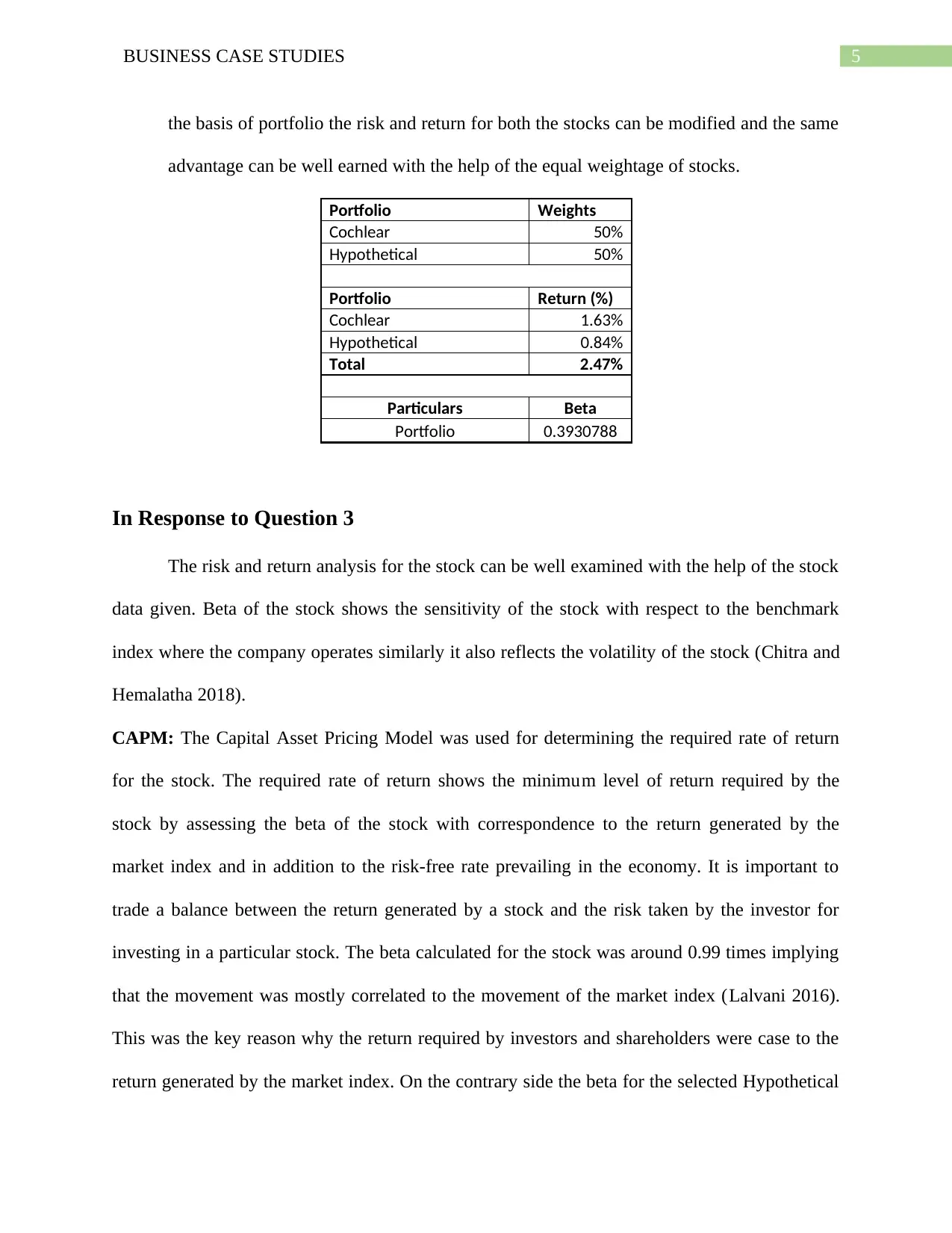
5BUSINESS CASE STUDIES
the basis of portfolio the risk and return for both the stocks can be modified and the same
advantage can be well earned with the help of the equal weightage of stocks.
Portfolio Weights
Cochlear 50%
Hypothetical 50%
Portfolio Return (%)
Cochlear 1.63%
Hypothetical 0.84%
Total 2.47%
Particulars Beta
Portfolio 0.3930788
In Response to Question 3
The risk and return analysis for the stock can be well examined with the help of the stock
data given. Beta of the stock shows the sensitivity of the stock with respect to the benchmark
index where the company operates similarly it also reflects the volatility of the stock (Chitra and
Hemalatha 2018).
CAPM: The Capital Asset Pricing Model was used for determining the required rate of return
for the stock. The required rate of return shows the minimum level of return required by the
stock by assessing the beta of the stock with correspondence to the return generated by the
market index and in addition to the risk-free rate prevailing in the economy. It is important to
trade a balance between the return generated by a stock and the risk taken by the investor for
investing in a particular stock. The beta calculated for the stock was around 0.99 times implying
that the movement was mostly correlated to the movement of the market index (Lalvani 2016).
This was the key reason why the return required by investors and shareholders were case to the
return generated by the market index. On the contrary side the beta for the selected Hypothetical
the basis of portfolio the risk and return for both the stocks can be modified and the same
advantage can be well earned with the help of the equal weightage of stocks.
Portfolio Weights
Cochlear 50%
Hypothetical 50%
Portfolio Return (%)
Cochlear 1.63%
Hypothetical 0.84%
Total 2.47%
Particulars Beta
Portfolio 0.3930788
In Response to Question 3
The risk and return analysis for the stock can be well examined with the help of the stock
data given. Beta of the stock shows the sensitivity of the stock with respect to the benchmark
index where the company operates similarly it also reflects the volatility of the stock (Chitra and
Hemalatha 2018).
CAPM: The Capital Asset Pricing Model was used for determining the required rate of return
for the stock. The required rate of return shows the minimum level of return required by the
stock by assessing the beta of the stock with correspondence to the return generated by the
market index and in addition to the risk-free rate prevailing in the economy. It is important to
trade a balance between the return generated by a stock and the risk taken by the investor for
investing in a particular stock. The beta calculated for the stock was around 0.99 times implying
that the movement was mostly correlated to the movement of the market index (Lalvani 2016).
This was the key reason why the return required by investors and shareholders were case to the
return generated by the market index. On the contrary side the beta for the selected Hypothetical
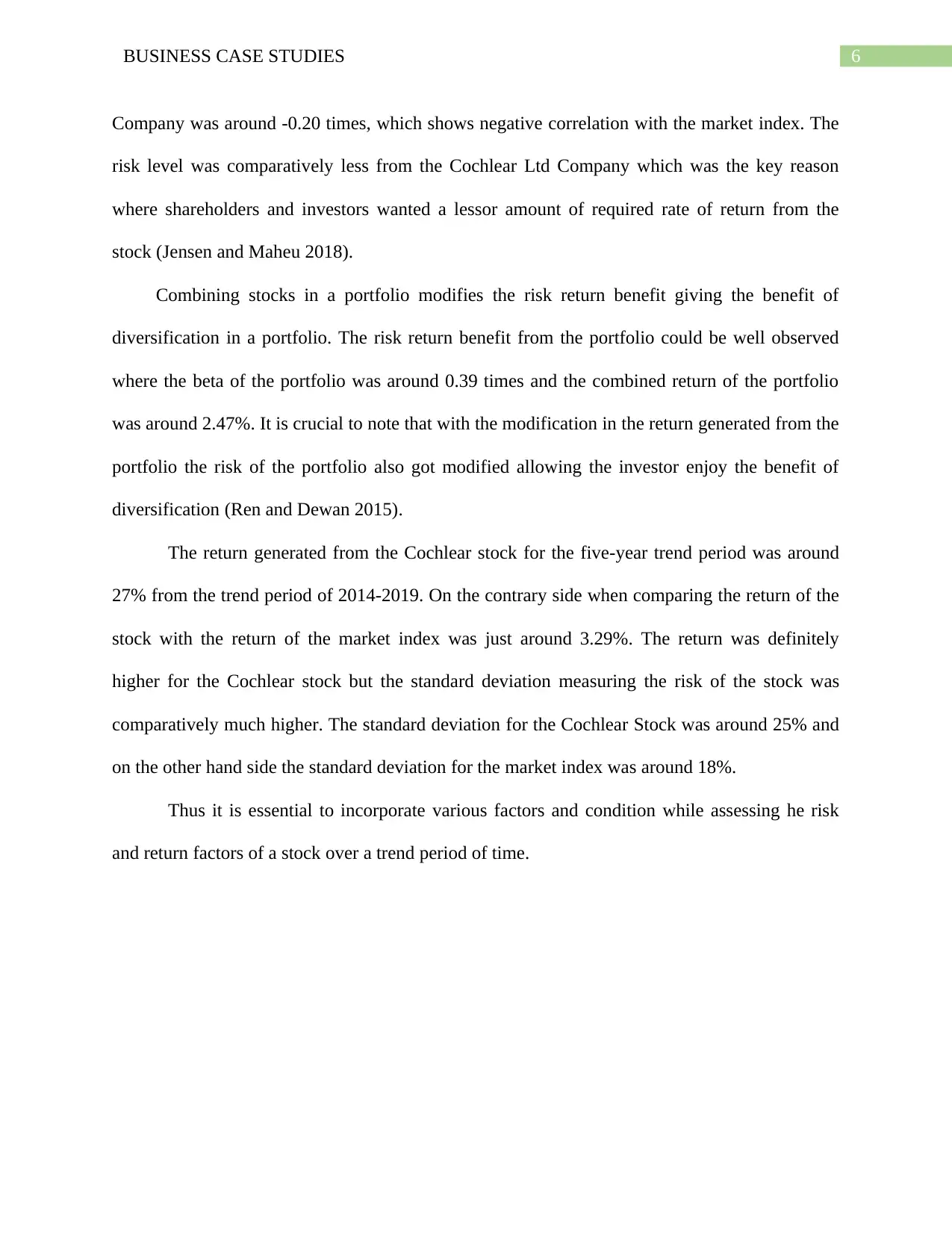
6BUSINESS CASE STUDIES
Company was around -0.20 times, which shows negative correlation with the market index. The
risk level was comparatively less from the Cochlear Ltd Company which was the key reason
where shareholders and investors wanted a lessor amount of required rate of return from the
stock (Jensen and Maheu 2018).
Combining stocks in a portfolio modifies the risk return benefit giving the benefit of
diversification in a portfolio. The risk return benefit from the portfolio could be well observed
where the beta of the portfolio was around 0.39 times and the combined return of the portfolio
was around 2.47%. It is crucial to note that with the modification in the return generated from the
portfolio the risk of the portfolio also got modified allowing the investor enjoy the benefit of
diversification (Ren and Dewan 2015).
The return generated from the Cochlear stock for the five-year trend period was around
27% from the trend period of 2014-2019. On the contrary side when comparing the return of the
stock with the return of the market index was just around 3.29%. The return was definitely
higher for the Cochlear stock but the standard deviation measuring the risk of the stock was
comparatively much higher. The standard deviation for the Cochlear Stock was around 25% and
on the other hand side the standard deviation for the market index was around 18%.
Thus it is essential to incorporate various factors and condition while assessing he risk
and return factors of a stock over a trend period of time.
Company was around -0.20 times, which shows negative correlation with the market index. The
risk level was comparatively less from the Cochlear Ltd Company which was the key reason
where shareholders and investors wanted a lessor amount of required rate of return from the
stock (Jensen and Maheu 2018).
Combining stocks in a portfolio modifies the risk return benefit giving the benefit of
diversification in a portfolio. The risk return benefit from the portfolio could be well observed
where the beta of the portfolio was around 0.39 times and the combined return of the portfolio
was around 2.47%. It is crucial to note that with the modification in the return generated from the
portfolio the risk of the portfolio also got modified allowing the investor enjoy the benefit of
diversification (Ren and Dewan 2015).
The return generated from the Cochlear stock for the five-year trend period was around
27% from the trend period of 2014-2019. On the contrary side when comparing the return of the
stock with the return of the market index was just around 3.29%. The return was definitely
higher for the Cochlear stock but the standard deviation measuring the risk of the stock was
comparatively much higher. The standard deviation for the Cochlear Stock was around 25% and
on the other hand side the standard deviation for the market index was around 18%.
Thus it is essential to incorporate various factors and condition while assessing he risk
and return factors of a stock over a trend period of time.
Paraphrase This Document
Need a fresh take? Get an instant paraphrase of this document with our AI Paraphraser
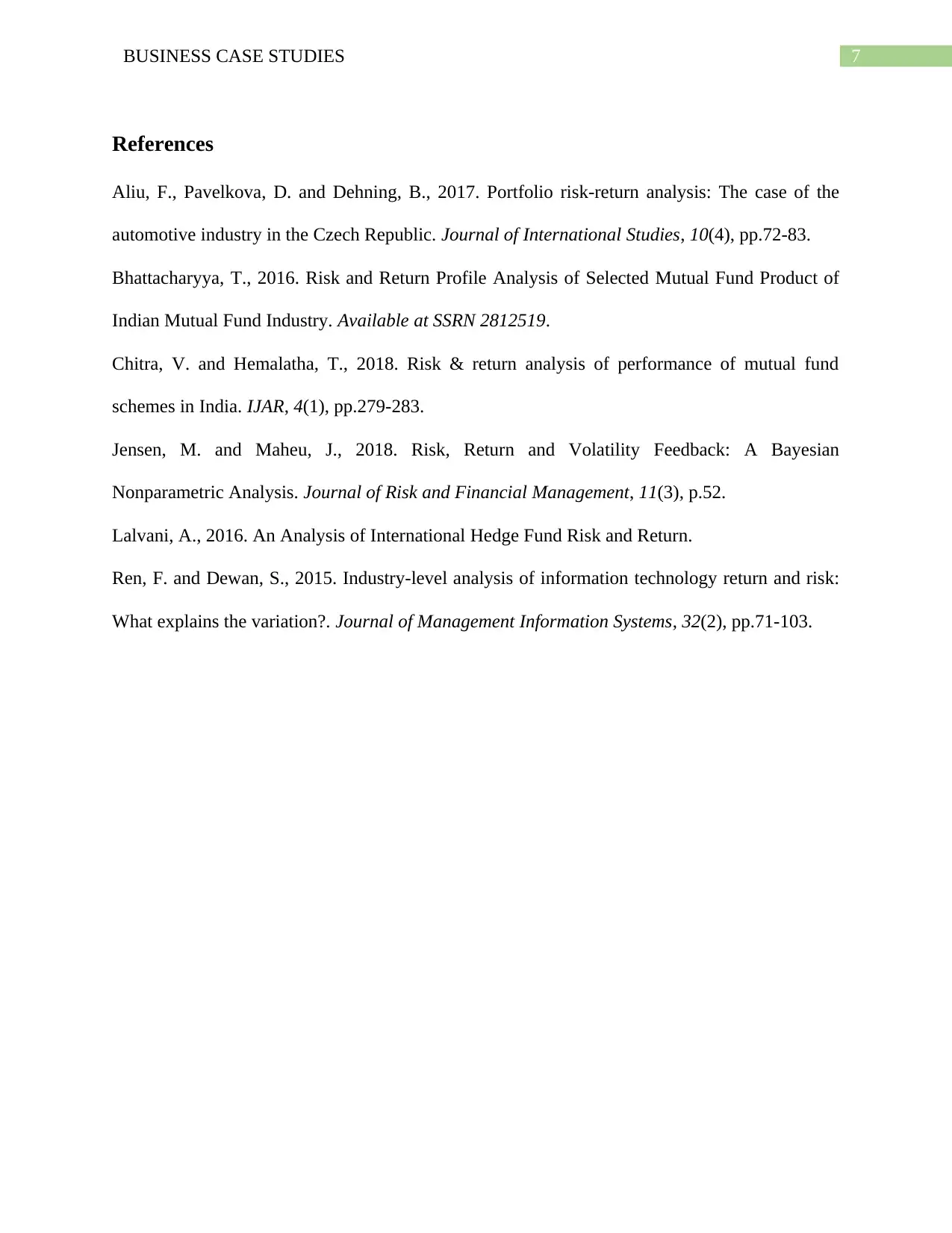
7BUSINESS CASE STUDIES
References
Aliu, F., Pavelkova, D. and Dehning, B., 2017. Portfolio risk-return analysis: The case of the
automotive industry in the Czech Republic. Journal of International Studies, 10(4), pp.72-83.
Bhattacharyya, T., 2016. Risk and Return Profile Analysis of Selected Mutual Fund Product of
Indian Mutual Fund Industry. Available at SSRN 2812519.
Chitra, V. and Hemalatha, T., 2018. Risk & return analysis of performance of mutual fund
schemes in India. IJAR, 4(1), pp.279-283.
Jensen, M. and Maheu, J., 2018. Risk, Return and Volatility Feedback: A Bayesian
Nonparametric Analysis. Journal of Risk and Financial Management, 11(3), p.52.
Lalvani, A., 2016. An Analysis of International Hedge Fund Risk and Return.
Ren, F. and Dewan, S., 2015. Industry-level analysis of information technology return and risk:
What explains the variation?. Journal of Management Information Systems, 32(2), pp.71-103.
References
Aliu, F., Pavelkova, D. and Dehning, B., 2017. Portfolio risk-return analysis: The case of the
automotive industry in the Czech Republic. Journal of International Studies, 10(4), pp.72-83.
Bhattacharyya, T., 2016. Risk and Return Profile Analysis of Selected Mutual Fund Product of
Indian Mutual Fund Industry. Available at SSRN 2812519.
Chitra, V. and Hemalatha, T., 2018. Risk & return analysis of performance of mutual fund
schemes in India. IJAR, 4(1), pp.279-283.
Jensen, M. and Maheu, J., 2018. Risk, Return and Volatility Feedback: A Bayesian
Nonparametric Analysis. Journal of Risk and Financial Management, 11(3), p.52.
Lalvani, A., 2016. An Analysis of International Hedge Fund Risk and Return.
Ren, F. and Dewan, S., 2015. Industry-level analysis of information technology return and risk:
What explains the variation?. Journal of Management Information Systems, 32(2), pp.71-103.
1 out of 8
Related Documents
Your All-in-One AI-Powered Toolkit for Academic Success.
+13062052269
info@desklib.com
Available 24*7 on WhatsApp / Email
![[object Object]](/_next/static/media/star-bottom.7253800d.svg)
Unlock your academic potential
© 2024 | Zucol Services PVT LTD | All rights reserved.





